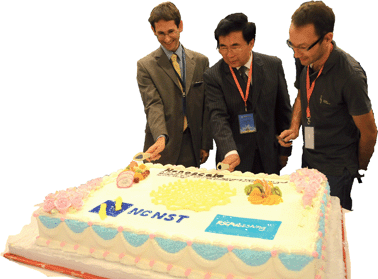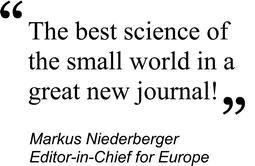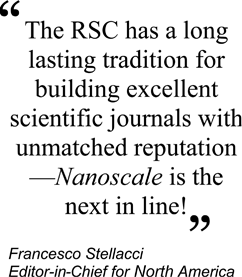Nanoscale—a new journal
Welcome to the inaugural issue of Nanoscale, the new nanoscience and nanotechnology journal from RSC Publishing.Nanoscale is intended to showcase important and high quality nano-research, providing a forum that will be essential reading for all the scientific communities working at the nanoscale.
As the very name Nanoscale suggests, our new journal will be highly interdisciplinary, appealing to researchers spanning the breadth of experimental and theoretical nanoscience and nanotechnology. Many communities are engaged in “cutting-edge” nanoscience of the highest importance: through Nanoscale we aspire to serve our readership with a lively high-impact mix of articles and article types that will be of great interest to the physicist, chemist, biologist, materials scientist, medicinal and biomedical researcher and engineer alike.
From launch, the latest issue of Nanoscale will be made freely available to all readersvia the website—www.rsc.org/nanoscale. Free online institutional access to all 2009 and 2010 content will be available following a simple registration process. Publishing in Nanoscale will therefore ensure your work will benefit from great exposure across our many readership communities.
All submissions to the journal will be handled by our exceptional team of Scientific Editors, who are extremely well qualified to manage the peer review process in a rigorous yet fair and efficient manner. We are proud to have three co-Editors-in-Chief managing submissions to editorial offices in three different continents.
Professor Chunli Bai, Director of the National Center for Nanoscience and Technology (NCNST) in Beijing, China and Executive Vice-President of the Chinese Academy of Sciences, is Editor-in-Chief of the Nanoscale Asia-Pacific editorial office. The European editorial office is led by Professor Markus Niederberger of ETH Zurich, whilst Professor Francesco Stellacci from Massachusetts Institute of Technology is Editor-in-Chief of our Americas editorial office.
Nanoscale will benefit from the 160+ years of renowned publishing experience RSC Publishing brings. Science and technology require collaboration to thrive, and in this spirit Nanoscale is a collaborative venture between RSC Publishing and leading nanoscience research centre, the National Center for Nanoscience and Technology (NCNST) in Beijing, China, highlighting our truly international aspirations for the journal.
The Editor-in-Chief for the Asia-Pacific region, Professor Bai, is a keen proponent of this international enterprise: ‘National Center for Nanoscience and Technology is looking forward to collaborating with RSC Publishing in developing Nanoscale, so that we can work together to establish a new chapter in the process of promoting nanoscience and nanotechnology’.
Editor-in-Chief for Europe, Markus Niederberger, is delighted that RSC Publishing is expanding its nanoscience footprint: ‘RSC is and remains an acronym for quality—also for publishing groundbreaking results in nanoscience! I am looking forward to presenting the full fascination of the small world in a great new journal’.
 | ||
| Plate1 Cutting the Nanoscale cake at our launch reception, Beijing, September 2009 | ||
The launch of Nanoscale will complement and build on the nano-content already published across the RSC Publishing journal portfolio, providing authors in this rapid growth field with a new dedicated subject journal characterised by the quality, speed of publication and innovative technology for which RSC Publishing products are well known. Manuscripts can be easily submitted using our simple online system, and many published articles are enhanced with our award-winning ‘RSC Prospect’ electronic features.
In this our very first issue we demonstrate our commitment to publishing high-impact and multidisciplinary research of the highest quality covering all aspects of the nanoscale. The issue is led with a review on ‘Mechanised nanoparticles for drug delivery’ from Professor Sir Fraser Stoddart (Northwestern) and co-workers (DOI: 10.1039/b9nr00162j). Professor C. N. R. Rao (Bangalore) writes a minireview on the very topical area of graphene (DOI: 10.1039/b9nr00104b), whilst Professor Amanda Barnard (CSIRO) examines computational strategies to investigate the important field of predicting the potential risks associated with nanotechnology (DOI: 10.1039/b9nr00154a). From new research on the synthesis of nanostructures (Markus Antonietti et al., DOI: 10.1039/b9nr00149b) to using nanoparticles for photocatalytic water splitting under visible light (Kazunari Domen et al., DOI: 10.1039/b9nr00186g), from self-healing at the nanoscale (Vincenzo Amendola and Moreno Meneghetti, DOI: 10.1039/b9nr00146h) to innovative uses of SERS (Naomi Halas et al., DOI: 10.1039/b9nr00063a) and developing silver-coated carbon nanotubes for SERS detection of cocaine (Luis Liz-Marzán et al., DOI: 10.1039/b9nr00059c), our inaugural issue is bursting with examples of important and wide-ranging high-impact research that will be found within these pages.
We very much hope you enjoy this our first issue. Do make sure you stay in touch with the latest exciting research published in Nanoscale—visit www.rsc.org/nanoscale to sign up for our free and convenient electronic contents alerts for subsequent issues, as well as our lively newsletter.
Of course, we welcome your submissions of high-quality original research. Articles can be submitted via our website—further details and other editorial information are below. If you are interested in writing a review-type article, please do contact the Editorial Office at mailto:nanoscale@rsc.org to discuss this further.
Finally, we are committed to developing and taking forward Nanoscale so that the journal fully meets the aspirations of the broad research communities we serve. We always welcome comments, suggestions and feedback; as ever, please do contact us at mailto:nanoscale@rsc.org with your views and feedback.
With our best wishes,
Chunli Bai, Markus Niederberger and Francesco Stellacci, Editors-in-Chief
Philip Earis, Managing Editor
 | ||
| Plate2 Chunli Bai, Editor-in-Chief, Asia-Pacific | ||
 | ||
| Plate3 Markus Niederberger, Editor-in-Chief, Europe | ||
 | ||
| Plate4 Francesco Stellacci, Editor-in-Chief, North America | ||
 | ||
| Plate5 Philip Earis, Managing Editor | ||
Editorial information
Article types
Nanoscale publishes a lively mix of article types, including original research Papers and Communications, Feature Articles, Minireviews, and important Reviews from leaders in the field. All articles submitted to Nanoscale are subject to rigorous peer review by international expert referees. All accepted articles are published online as fully citeable Advance Articles as soon as they are ready.Free online access
Nanoscale will be published in monthly issues. The journal is published by RSC Publishing—a leading learned society publisher, with a proud history of publishing excellence and innovation in electronic developments.To maximise the visibility of work published, the current issue of Nanoscale—plus any Advance Articles—will be freely available to all on our website (www.rsc.org/nanoscale).
In addition, the entire 2009 and 2010 content will be freely available following a simple registration process. Access is managed by institution and IP address. Make sure your organisation takes advantage of this by registering at www.rsc.org/free_access_registration
Browsing and alerting services
The Nanoscale homepage contains the contents list for the current issue, delivering the content you want to see as soon as you arrive at the site. Graphical abstracts are included as standard, allowing you to easily browse content. A prominent and easy-to-use search box also makes finding published research much more intuitive.RSS feeds for Nanoscale also include graphical abstracts, enabling at-a-glance identification of relevant articles. To get the latest articles delivered straight to your screen, sign up at www.rsc.org/rss—or you can sign up for e-mail contents alerts at www.rsc.org/alerts
Submission details
We actively welcome submissions (in any reasonable format), through our simple ManuscriptCentral submissions service (http://mc.manuscriptcentral.com/nr).Our full author guidelines, including preferred referencing style, are available on the Nanoscale website at www.rsc.org/nanoscale. Our journal templates (available from the website) are designed to assist submission in a format similar to the journal layout. However, we are willing to consider articles in almost any reasonable format and layout.
Of course, all published articles are put into a clear and attractive standardised format by our professional technical staff.
Colour policy
We are happy to print figures in colour, free of charge, where the use of colour enhances the scientific understanding of the figure. In addition, for the online version of the journals, colour is always provided at no cost in both the pdf and html versions.Citing
When you cite Nanoscale articles in future manuscripts please note that the correct journal abbreviation is simply Nanoscale.| This journal is © The Royal Society of Chemistry 2009 |


